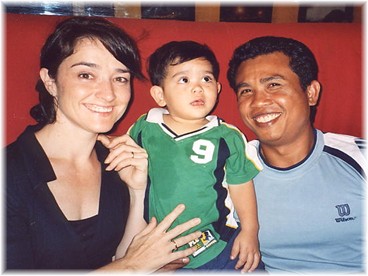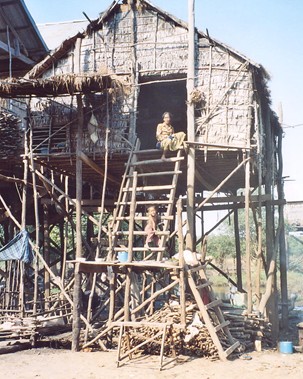 I spent an interesting few hours in the 'floating village' of Kompong Khleang on my most recent visit to Cambodia in January. Its a massive, sprawling community, believed to be the biggest of its kind on the Tonle Sap Lake and we spent an enjoyable morning there, and were made particularly welcome by the people we met. Much like its neighbour, Kompong Phluk, the main thoroughfare, during the dry season, looks like something out of a spaghetti-western film-set, with its high-rise homes set on tall wooden stilts along a dusty street. Above is a typical house on stilts though it will look completely different in the wet season, when the water level will rise substantially and the steps to the house will disappear under water. I certainly want to return at that time to experience the other side of Kompong Khleang.
I spent an interesting few hours in the 'floating village' of Kompong Khleang on my most recent visit to Cambodia in January. Its a massive, sprawling community, believed to be the biggest of its kind on the Tonle Sap Lake and we spent an enjoyable morning there, and were made particularly welcome by the people we met. Much like its neighbour, Kompong Phluk, the main thoroughfare, during the dry season, looks like something out of a spaghetti-western film-set, with its high-rise homes set on tall wooden stilts along a dusty street. Above is a typical house on stilts though it will look completely different in the wet season, when the water level will rise substantially and the steps to the house will disappear under water. I certainly want to return at that time to experience the other side of Kompong Khleang.
Saturday, March 31, 2007
Kompong Khleang's film-set
Friday, March 30, 2007
Noung's latest photo
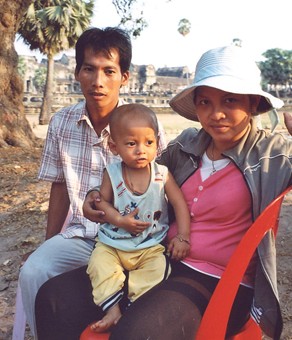 In March 1998 I first met Noung in the corridors of Angkor Wat. She was a bright and bubbly twelve year old souvenir seller, and we've remained good friends ever since. You can see some photos of Noung through the years here. I hadn't seen her on my last couple of visits to Cambodia, so in January I was determined to track her down and I was in luck. She'd just returned to work at her stall in the grounds of Angkor Wat and was accompanied by her husband, Mean Somnang and their very recent addition to their family. Noung and her family are still at Angkor Wat, every day, and husband Somnang is a camry driver and can be contacted on 012 636 094. One reunion that I wasn't expecting was with Noung's elder sister, Socheata. However, I'll tell you about that in another posting.
In March 1998 I first met Noung in the corridors of Angkor Wat. She was a bright and bubbly twelve year old souvenir seller, and we've remained good friends ever since. You can see some photos of Noung through the years here. I hadn't seen her on my last couple of visits to Cambodia, so in January I was determined to track her down and I was in luck. She'd just returned to work at her stall in the grounds of Angkor Wat and was accompanied by her husband, Mean Somnang and their very recent addition to their family. Noung and her family are still at Angkor Wat, every day, and husband Somnang is a camry driver and can be contacted on 012 636 094. One reunion that I wasn't expecting was with Noung's elder sister, Socheata. However, I'll tell you about that in another posting.
A boy's night out
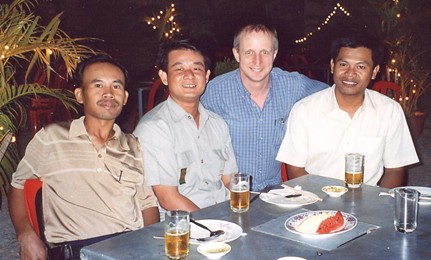 Here's a photo from a boy's night out I had with three of my very close friends who live in Siem Reap, during my Cambodia visit in January. From left to right, they are Rieng, Heang, me and Phalla. I always touch base with them when I'm in Cambodia but usually its individually, so this gathering was a special occasion and the beers were on me to celebrate. I don't drink alcohol but that didn't stop them! Rieng is a brilliant guide, Heang is a top-notch driver and Phalla has moved back to Siem Reap to work for a travel company. Over the last few years I've had some great travel experiences with these guys and I hope to have lots more. You can find out more about Rieng and Heang here.
Here's a photo from a boy's night out I had with three of my very close friends who live in Siem Reap, during my Cambodia visit in January. From left to right, they are Rieng, Heang, me and Phalla. I always touch base with them when I'm in Cambodia but usually its individually, so this gathering was a special occasion and the beers were on me to celebrate. I don't drink alcohol but that didn't stop them! Rieng is a brilliant guide, Heang is a top-notch driver and Phalla has moved back to Siem Reap to work for a travel company. Over the last few years I've had some great travel experiences with these guys and I hope to have lots more. You can find out more about Rieng and Heang here.
A fishy tale in Kompong Khleang
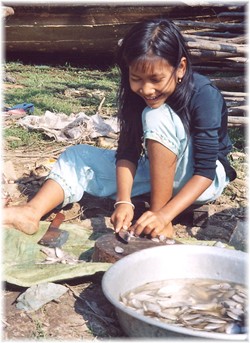 This young girl was amongst a group of women of all ages who were gutting the day's catch of fish in the village of Kompong Khleang, during my visit there in January. In fact, under the stilts of every second or third house along the main street, were groups of women, happy in their work, and keen to engage me in banter and laughter. I was invited to lunch by two of the groups and even asked to return three days later for a big festival in the village. Everyone was ultra friendly. Kompong Khleang is the biggest of the floating villages on the Tonle Sap Lake, believed to house about 30,000 inhabitants but for my visit, we managed to drive our 4WD all the way to the village, whereas for much of the year, the houses are built on very large stilts for good reason. Aside from the upper half of the market, the main pagoda and the primary school, the rest of the village is under water for long periods. Like its neighboring floating village, Kompong Phluk, it makes for a very interesting and engaging half-day trip from Siem Reap. Its 51kms from door to door. Give it a go, you won't be disappointed.
This young girl was amongst a group of women of all ages who were gutting the day's catch of fish in the village of Kompong Khleang, during my visit there in January. In fact, under the stilts of every second or third house along the main street, were groups of women, happy in their work, and keen to engage me in banter and laughter. I was invited to lunch by two of the groups and even asked to return three days later for a big festival in the village. Everyone was ultra friendly. Kompong Khleang is the biggest of the floating villages on the Tonle Sap Lake, believed to house about 30,000 inhabitants but for my visit, we managed to drive our 4WD all the way to the village, whereas for much of the year, the houses are built on very large stilts for good reason. Aside from the upper half of the market, the main pagoda and the primary school, the rest of the village is under water for long periods. Like its neighboring floating village, Kompong Phluk, it makes for a very interesting and engaging half-day trip from Siem Reap. Its 51kms from door to door. Give it a go, you won't be disappointed.
Thursday, March 29, 2007
Adoption success story
 I reported a few days ago that Kari Grady Grossman's brand new book, Bones That Float, A Story of Adopting Cambodia had been published. All proceeds from the book will benefit a school that Kari sponsors in the Kompong Speu area of Cambodia. She tells me that the book is available from her website, as well as Amazon.com and bookstores, and that pre-sales have already totalled 500+. This review of the book by Loung Ung, author of First They Killed My Father and After They Killed My Father, says it all:
I reported a few days ago that Kari Grady Grossman's brand new book, Bones That Float, A Story of Adopting Cambodia had been published. All proceeds from the book will benefit a school that Kari sponsors in the Kompong Speu area of Cambodia. She tells me that the book is available from her website, as well as Amazon.com and bookstores, and that pre-sales have already totalled 500+. This review of the book by Loung Ung, author of First They Killed My Father and After They Killed My Father, says it all:
“Bones That Float is Kari Grady Grossman’s tender tale of her journey to find her son in Cambodia. But more than an adoption story, this beautifully written book brings to light the external, internal, and spiritual struggles mothers of internationally adoptive children face in their new roles. As a mother, Kari understands the cultural and emotional issues her son, like many other young Asian Americans today, will face in our contemporary American society. As a writer, she knows that Asian Americans are more than the one dimensional characters they are often portrayed on television and in films. Instead, they are a juxtaposition of old and new world views, proud of their cultures but also finding that sometimes they have to rebel against traditions that keep them down. Like her son, today’s Asian American youths will have to break molds and barriers to create a new mosaic of families, lives, and multi-national identities in their increasingly global world. In her desire to understand and make whole her son’s two countries, Kari integrates both cultures into her heart and their lives so successfully, she’s fallen in love with her son’s ‘other’ brothers and sisters in Cambodia. This led Kari to return to Cambodia many times to build a school and become ‘mama’ to over 450 children. Told with fierce honesty and an affecting voice, Bones that Float is a love story of mother for her child, and a testimony of how love can change the world.”
Tuesday, March 27, 2007
A Monkolborei champion
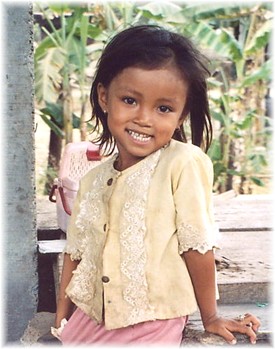 I couldn't resist posting this picture. It brings wonderful and poignant memories flooding back. It was taken just before I demolished a plateful of chicken curry cooked by this little girl's mother in a small village on the outskirts of Monkolborei, in northwest Cambodia, in January. We'd been playing catch for the previous ten minutes and her prize for not dropping the ball was a 50 riel note, which she held onto for dear life. It was at the home of my guide, Sak's sister-in-law and husband, Nouv and Jantou. And just around the corner from Wat Anchan, where the Khmer Rouge had held Sak as a child during their genocidal grip over the country and forced him to smash religious artifacts and Buddha statues.
I couldn't resist posting this picture. It brings wonderful and poignant memories flooding back. It was taken just before I demolished a plateful of chicken curry cooked by this little girl's mother in a small village on the outskirts of Monkolborei, in northwest Cambodia, in January. We'd been playing catch for the previous ten minutes and her prize for not dropping the ball was a 50 riel note, which she held onto for dear life. It was at the home of my guide, Sak's sister-in-law and husband, Nouv and Jantou. And just around the corner from Wat Anchan, where the Khmer Rouge had held Sak as a child during their genocidal grip over the country and forced him to smash religious artifacts and Buddha statues.
Beng Mealea's Guardian - Chheng Chhun
 Not quite as famous as Choun Nhiem, the leaf-sweeper of Ta Prohm, but an institution in his own right is Chheng Chhun, the 72-year-old guardian/conservateur/guide at the temple of Beng Mealea, some 40kms from the Angkor complex in Cambodia. This is Chhun and myself at our reunion in January this year, some seven years after we first met, in December 1999. Back then Chhun took me around a very overgrown Beng Mealea - boy was it hard work though he made it look easy - before it became the sanitized version you see today. However, this time around I wanted Chhun to show me some of the temples that lie further east along the old royal road and with his help, we managed to visit Prasat Teap Chei, Prasat Kongpluk and Prasat Chrey as well as two laterite bridges enroute. Born near Beng Mealea, he knows the area like the back of his hand and despite his advanced years, he thought nothing of a twenty-minute slog through seriously dense undergrowth to reach Prasat Teap Chei. If you do venture out to Beng Mealea - visitor numbers can reach 50+ per day - seek out Chhun, as no-one knows that area better than him.
Not quite as famous as Choun Nhiem, the leaf-sweeper of Ta Prohm, but an institution in his own right is Chheng Chhun, the 72-year-old guardian/conservateur/guide at the temple of Beng Mealea, some 40kms from the Angkor complex in Cambodia. This is Chhun and myself at our reunion in January this year, some seven years after we first met, in December 1999. Back then Chhun took me around a very overgrown Beng Mealea - boy was it hard work though he made it look easy - before it became the sanitized version you see today. However, this time around I wanted Chhun to show me some of the temples that lie further east along the old royal road and with his help, we managed to visit Prasat Teap Chei, Prasat Kongpluk and Prasat Chrey as well as two laterite bridges enroute. Born near Beng Mealea, he knows the area like the back of his hand and despite his advanced years, he thought nothing of a twenty-minute slog through seriously dense undergrowth to reach Prasat Teap Chei. If you do venture out to Beng Mealea - visitor numbers can reach 50+ per day - seek out Chhun, as no-one knows that area better than him.
Monday, March 26, 2007
Dance reminder : Film premiere
Dance reminder:
The first appearance of the Cambodian dance epic, Weyreap's Battle, takes place at London's Barbican Theatre this coming Friday 30 March thru to 1 April. The story itself is taken from the Reamker, Cambodia's version of the Indian poem Ramayana, and depicts a monumental struggle between good and evil, with a cast of monkey armies, human kings and queens, giants and underwater sea creatures. The production is staged within the conventions of the 10th-century male dance form - Lakhaon Kaol - with its ancient complex repertory of gesture and its spectacular masks and costumes. Find out more at www.amritaperformingarts.org. Ongoing projects for Amrita also include 3 Years, 8 Months, 20 Days: a new play directed by the renowned Dutch director Annemarie Prins, depicting the lives of three actresses during the Khmer Rouge regime. The piece premiered in February 2006 and is scheduled to perform at the 2007 Singapore International Arts Festival in June, with a possible tour to Europe.
Film premiere:
The first public screening of a new film by Beth Pielert, Out of the Poison Tree, will take place at Berkeley University, California on Friday 6 April. There will be a special performance by one of the film's main characters, Cambodian rap artist, PraChly, and a Q&A session with the director afterwards. The film has been seven years in the making and will include interviews with Youk Chhang, director of DC-Cam, PraChly, and Aki Ra, who has just announced his retirement from his landmine museum in Siem Reap. On the eve of the long-awaited Khmer Rouge trial, an American survivor of the genocide, Thida Buth Mam, returns to Cambodia hoping to unlock the mystery of her father's disappearance in 1975. Her quest intersects with many silent voices: widows, survivors from remote villages, monks and even former perpetrators. Her search for the truth stirs up the fractured pieces of one family's nightmare, unearths an unimaginable heartbreak and ultimately shines light on a people's broken silence. Find out more about the film at their website: www.goodfilmworks.com.
Sunday, March 25, 2007
Sokhom - all round top bloke
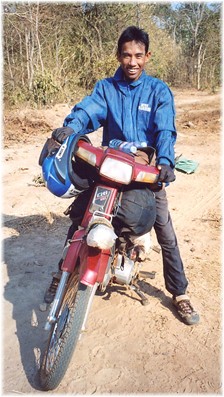 I can never shower enough praise onto the shoulders of my favourite people in Cambodia. One of them is Sokhom, my best friend, guide, translator, moto-driver and all round top bloke. He lives in Kompong Thom and this is how I describe him on my Recommended Guides webpage on my site:-
I can never shower enough praise onto the shoulders of my favourite people in Cambodia. One of them is Sokhom, my best friend, guide, translator, moto-driver and all round top bloke. He lives in Kompong Thom and this is how I describe him on my Recommended Guides webpage on my site:-Im Sokhom was born in Phnom Penh forty years ago. He survived the Pol Pot years and fled the country for a refugee camp on the Thai border before returning in 1992 to settle in Kompong Thom. English-speaking moto-drivers in Kompong Thom are a rarity, so Sokhom has become something of a minor celebrity with a name-check in English, German and Japanese guidebooks as the man to track down in his town. His expert knowledge of his own province and those further north is invaluable to anyone seeking to explore this fascinating part of the country. He was presented with a bicycle recently by a satisfied group of touring cyclists, so can also accommodate that mode of transport if required. You can contact Sokhom by telephone: (855) 012 691 527 or by e-mail: guideimsokhom@yahoo.com or or guideimsokhom@hotmail.com.
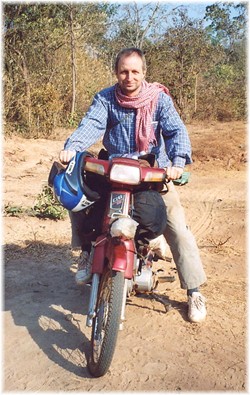
Saturday, March 24, 2007
Bones That Float in Cambodia
Hot off the press, the first book relating to Cambodian adoption, entitled Bones That Float, A Story of Adopting Cambodia, has just this minute been published independently by author Kari Grady Grossman, so that proceeds from the book can benefit a school she sponsors in Cambodia. Check out the school here. Meanwhile, you can read all about the book at www.BonesThatFloat.com.
In March 2001, American writer Kari Grady Grossman walked into a crowded orphanage outside Phnom Penh, Cambodia, and met her eight-month-old son. One of the first questions Kari asked was, “How did he get here?” The complex and, at times, heartwrenching answer is told in this magnificent book that encompasses Kari’s personal journey to adoption, Cambodia’s gruesome history of war and genocide, and the stories of two Cambodians - one who escaped the Khmer Rouge’s bloody reign and one who did not.
The interweaving stories grab your heartstrings and never let go. From the moment Kari realizes that she will never be an “earth momma” practicing prenatal yoga to years later, as Kari wends her way on the back of a moto-taxi through Phnom Penh’s smog-choked streets trying to make a difference in her son’s birth nation, you can’t read impassively. Bones That Float takes you into the Khmer Rouge jungle where boy soldiers force starving families to labor all day at gunpoint, and it brings you to modern-day Phnom Penh streets where foreign pedophiles purchase the innocence of preteen Cambodian girls. But ultimately Bones That Float - a Cambodian phrase for the sacred that rises above the suffering - is a tale of hope. Kari reminds us that our world is “one big family” and that we cannot - or dare not - turn our backs on people who suffer, in part because of our own country’s foreign policy missteps. To read Bones That Float is to open your heart to caring.
Tuesday, March 20, 2007
Yaz Alexander's new EP
 Saturday night at The Drum in Birmingham, saw the debut performance of Empress, Yaz Alexander's title track from her brand new EP, available for the first time that same evening. Empress is a self-penned three minute track, one of 7 on the EP: 1. Empress, 2. Black Pride, 3. This World, 4. More Love, 5. Peace (feat Cosimo Scairato), 6. Don't Trust Love, 7. Step Right Ahead. You can find out more about Yaz on her website or email here.
Saturday night at The Drum in Birmingham, saw the debut performance of Empress, Yaz Alexander's title track from her brand new EP, available for the first time that same evening. Empress is a self-penned three minute track, one of 7 on the EP: 1. Empress, 2. Black Pride, 3. This World, 4. More Love, 5. Peace (feat Cosimo Scairato), 6. Don't Trust Love, 7. Step Right Ahead. You can find out more about Yaz on her website or email here.
New Year Baby UK Premiere
Well, technically, the premiere was in Milton Keynes the previous evening, but Oxford played host to only the second UK screening of New Year Baby yesterday, as part of the OXDOX film festival, and I have to say, its an excellent film. Great credit to the team of Socheata Poeuv and Charles Vogl (and another great team behind them) for producing a moving and enriching 75-minute documentary as Socheata herself, uncovers family secrets that had lain dormant for 25 years. As we are treated to Socheata and her family's personal journey into their roots, the real hero of the story is revealed as Socheata's father, who with typical Khmer sense of humour and humility, steals every scene in which he appears. The return to the Khao-I-Dang refugee camp and the 'birth' ceremony towards the end of the film were very powerful moments, as were the revelations from Socheata's adopted sisters, and few will get through the film without shedding a tear or three. There was also an unexpected animation section in the film, which I thought worked perfectly. Socheata's nickname is 'the lucky one' and she is, to have parents of such strength and character and a wonderful family who, as typical of so many Khmer families, have been through so much, survived and have become stronger as a consequence.
You can read a lot more about the film at their website and can still catch the film in London tomorrow night (Tuesday) at The Renoir. I hope the film gets taken up by one of the tv channels as its a powerful and personal story that needs to be seen by a much wider audience. It was also good to meet Richard Chappell at the showing, who's responsible for bringing over the master musician Kong Nay from Cambodia, who will play at the WOMAD festival in late July, and who is also arranging for other performances around the country, together with a showing of another excellent documentary, The Flute Player. Watch out for the dates for this unique opportunity to see a living Cambodian master musician. If you want to book the film & performance between 22 July and 5 August, email Richard here.
Sunday, March 18, 2007
Loung Ung interview - Sunday Times March 2007
From The Sunday Times, March 18, 2007
I always knew I’d find my sister again
When Loung Ung fled the terror of Pol Pot’s Cambodia she had to leave part of her family behind. She tells Jon Swain how they were reunited after 15 years.
By the age of 10, Loung Ung had endured the killing of her mother and father and the deaths of two sisters at the hands of the Khmer Rouge. She had fought off a soldier who tried to rape her and had suffered starvation and forced labour.
In the cruel roulette of life the little Cambodian girl with beautiful sad eyes seemed to be an especially tragic loser. A child of the Killing Fields, she had been denied even laughter as she grew up. Last week, poised and beautiful, she was in London to talk about her life. “I should have been dead,” she said. “I was so lost I did not even know my birthday.”
Pol Pot had turned the clock back to Year Zero, telling the millions of Cambodians toiling in the giant labour camp their beautiful country had become, that “to spare you is no profit, to destroy you is no loss”. His genocidal regime killed an estimated 2m people through murder, disease, malnutrition and overwork.
In 1980, after the Khmer Rouge’s defeat, Loung’s older brother Meng resolved to escape from the hell of their once gentle home-land. There were only two ways out: walk through the minefields to the Thai border, or flee by boat. But that required him to raise enough gold to pay a smuggler and he was able to borrow enough for only three people.
He decided that they were to be him, his wife Eang and either Loung or her 12-year-old sister Chou. “It was like the toss of a coin between Chou and me,” Loung, now 36, said. Meng chose Loung because she was the youngest and also because he believed she was fearless. Her Khmer Rouge upbringing had made her aggressive, not a good thing for girls in Cambodia. But it might be all right in America.
Although they were children, the sisters’ war-torn hearts were bound by their tragic past. They were inseparable. As she left her village of Bat Deng, Loung caught a last glimpse of Chou, her lips quivering and her face crumpled as tears streamed down her cheeks. “Her face stayed with me all through the trip to my new world,” Loung said.
Meng, Eang and Loung made it to a refugee camp in Thailand where Meng decided he did not want Loung ever to forget Cambodia. So with a few strokes of a pen on her asylum papers he made April 17 her birthday. That was the date in 1975 when Pol Pot’s victorious Khmer Rouge had taken the Cambodian capital Phnom Penh, forcing its 2m inhabitants at gunpoint out into the countryside to toil like ants in the fields.
The three refugees were eventually resettled in America, in the mountains of Vermont, through the sponsorship of a local church. Here, Loung went to school, started learning English and tried hard to be an American. She learnt to eat rice from a packet and marvelled at a country where strangers gave away sweets to children knocking on their doors at Hallowe’en.
Although she tried hard, she found it difficult to be accepted by other children who regarded her as a “party pooper”. Haunted by the images of her father’s death, she sat in the school counsellor’s office thinking she wanted to tell her that there was so much pain inside her that she was lonely and sad most of the time.
She never forgot Chou. When she left Cambodia she had vowed to herself that she would return in five years to see her beloved sister. But it was 15 years before she went back. In part that was because America had no diplomatic relations with then Vietnam-ese-dominated and communist Cambodia until 1993. In part it was because she could not face it.
“I had put all thoughts of seeing Chou out of my mind,” she said. “And through the years, as I became busy with school and life, I left Chou farther and farther behind until, in my mind, the oceans and 12,000 miles between us seemed impossible to cross.
“You see, I wanted to be normal. I wanted the American dream. I wanted more out of life than what war had given me. I wanted to have a good time. I wanted to be able to spend $20 on a meal and not feel guilty because it was my Cambodian brothers’ monthly income.”
Loung found that even her birthday was a huge weight to bear. Birthdays are about life; instead hers was connected with death. “I wanted to be frivolous on my birthday,” she said. “I wanted to get drunk. I wanted to dance on tables and I didn’t think you could do that being Cambodian. I wanted to be silly. I wanted to be sexy. But I could not do that.”
With hard work she distinguished herself at school and won a scholarship. But all this, she said, made her spend the next few years being “really selfish”.
“I bought expensive champagne and lived in the south of France for a while. It was not a bad thing because it taught me that like any other gratification it was not sustainable unless I shared it with loved ones.”
So in 1995 Loung went back to Cambodia for the first time and was reunited with Chou. “Before I went back I was so afraid. I was afraid that once I started crying I would not be able to stop,” she said. But Chou was waiting for her at the airport and even after all the time they had been apart it was like meeting an old friend.
Out of this poignant but uplifting story came Loung’s determination to tell the world about the Cambodian genocide. In 2000 she published an extraordinary book, First They Killed My Father. Initially rejected by 20 publishers, it went on to become a bestseller.
At the same time Loung became an activist, immersing herself in the campaign against landmines. Today she is a spokes-woman for the Cambodia Fund, a programme run by Veterans for America, helping disabled Cambodians and amputees.
She leads delegations to Cambodia several times a year. “I wanted to be a human being and if I didn’t speak out and live the life I wanted to live I might as well be still in the Khmer Rouge,” she said. “I felt I had been given a second opportunity of life and thought it would be a real shame, a real squander not to live it, not to grab it at the fullest, so that meant me being involved in the community and the world.” Her new book, After They Killed Our Father (Mainstream), deals with her tragic separation and eventual happy reunion with Chou and has just been published in Britain. She had to piece together Chou’s story from their numerous conversations and interviews with family members and neighbours.
While Loung was growing up in America, facing her own demons, Chou was living in a squalid village without electricity or running water and wishing she could have had an education. She had to endure many hardships, from a Khmer Rouge attack to the death of a young cousin who fell into a pot of boiling water. She, too, is a strong woman.
Since their reunion Loung has been back to Cambodia some 30 times. She said she likes nothing better than to travel on a motor-bike back to Bat Deng village and walk the paths of her childhood, sleep in a hammock in the great greenness of the countryside and play with her nephews and nieces.
Her books have made her a household name in Cambodia. But what impresses people most is her ability to eat the roughest peasant food — lizards, insects, crickets — without getting sick. “I have an iron stomach,” she said.
Recently, she has been looking at buying a property in Phnom Penh. “I have had great times in America. But the times I have spent with my family since we were united have been so much richer and have filled my heart with more spirit and feeling,” she said.
She adds that part of the inspiration to write another book stemmed from her disillusionment with the American invasion of Iraq and particularly President Bush’s aircraft carrier speech in 2003, after the overthrow of Saddam Hussein, proclaiming victory before a banner declaring “Mission accomplished”.
“I had hoped it was true and the war was over. But I knew it was not over and it made me start thinking of the whole story of what it takes to survive wars. I had written about surviving war and I wanted to tell the story of what it takes to survive the peace.”
Three years ago she married and now lives in Cleveland with her husband Mark. She has chosen not to have children: “My relatives in Cambodia think it is crazy. They are all up there at the temple shaking the incense, praying I will have a child.
“There are a lot of reasons why not. But definitely there is a fear if something happened to the child. I haven’t had anybody I loved die in a long time, since I left Cambodia in fact. I think if it happened I would have a complete meltdown.”
From war-torn Cambodia to America and back again has been an extraordinary, often painful, but poignantly uplifting odyssey for her and Chou. The tearful goodbyes they said one hot morning on a dusty road in Cambodia 27 years ago are long in the past.
She vows to be in Phnom Penh when the few remaining top killers of the Khmer Rouge are judged by a UNsponsored war crimes tribunal for crimes against humanity. “There is not a single thing that can compensate me for my parents’ death and the deaths of 2m people,” she said. “But I want to hear from their mouths why it happened.”
Re-produced courtesy of www.timesonline.co.uk
Sunday scribbles...
Just a few scribbles before I go & watch the documentary film New Year Baby at the OXDOC film festival in Oxford. Really looking forward to seeing it after reading so many reviews giving it great praise. I'll let you know what I think of it tomorrow.
I was disappointed when I bought the Sunday Times this morning...the eagerly-awaited interview with Loung Ung by Jon Swain was nowhere to be seen! That is until I looked at the www.timesonline.co.uk version, and there it was!
I got in after 4am this morning after attending a reggae concert in Birmingham, headlined by The Mighty Diamonds, a well-known reggae combo from Jamaica. As usual with all events at The Drum run by independent promoters, the concert started very late but it was great to see a 25-minute set by Yaz Alexander, singing her new release, Empress for the first time. Yaz sounded great, looked fantastic and really warmed the audience up for the main act. Disappointingly for me, the mic's for the Diamond's trio of vocalists were turned down far too low and left me feeling a bit cheated for a group that relies heavily on its vocal harmonies. Very frustrating. More on Yaz a little today.
Lastly, I spent most of yesterday celebrating the progress of Kidderminster Harriers through to the final of the FA Trophy, which will be played at Wembley in May. Though we lost 3-2 at Northwich on the day (though the referee had an absolute shocker of a match), we won 4-3 on aggregare over the two legged semi-final, so I'm still a bit hoarse this morning after shouting myself silly. Come on you Harriers!
Friday, March 16, 2007
An interview with filmmaker Socheata Poeuv
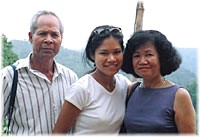 On the eve of the UK premiere of her award-winning documentary, New Year Baby, at the OXDOX Film Festival, filmmaker Socheata Poeuv (pictured above with her parents) took time out of her busy schedule promoting the film at various festivals around the world, to answer a few of my questions.
On the eve of the UK premiere of her award-winning documentary, New Year Baby, at the OXDOX Film Festival, filmmaker Socheata Poeuv (pictured above with her parents) took time out of her busy schedule promoting the film at various festivals around the world, to answer a few of my questions.
Sunday 18th March, 5.45pm at The Old Fire Station in Oxford (I'll be there).
Tuesday 20th March, 6.30pm at The Renoir in London.
To book your tickets, go to the OXDOX website here.
DC-Cam - Searching for the Truth
I cannot adequately summarise the incredibly invaluable work that is being done by Youk Chhang and his team at the Documentation Center of Cambodia (DC-Cam), so the best I can do is to direct you to their website where you can delve into their extraordinary success in educating Cambodians and the rest of the world about the crimes of the Khmer Rouge. They have been tireless in their quest for the truth and their work is as important as ever as the Tribunal of the former Khmer Rouge leaders that are still alive rumbles on. Their monthly magazine, their outreach programs, and their publications are all key elements in disseminating their message and information. Hot on the heels of two monographs from 2006, namely The Cham Rebellion (by Osman Ysa) and The Khmer Rouge Tribunal (by John D Ciorciari), are some new publications. Vanished: Stories from Cambodia's New People under Democratic Kampuchea is 52 survivor stories pieced together by Pivoine Beang and Wynne Cougill. To accompany a photo exhibition in the United States earlier this year, a 128-page catalogue called Night of the Khmer Rouge was produced and is now available. Also due out this year is Winds from the West: Khmer Rouge Purges in the Highlands of Mondulkiri by Sara Colm and Sorya Sim and books on the history of Tuol Sleng Genocide Museum and Nhem En, the KR's chief photographer. Also a film has been produced by Doug Kass and Youk Chhang called Behind the Walls of S-21 : Oral Histories from Tuol Sleng Prison. But believe me, these are just the tip of the iceberg when it comes to the work being done at the DC-Cam offices in Phnom Penh.
Thursday, March 15, 2007
Khmer New Year in the UK
The Cambodian community in the UK will celebrate Khmer New Year with two ceremonies next month. A formal religious ceremony will take place on Saturday 7th April at the Amaravati Buddhist Monastery at Great Gaddesden, near Hemel Hempstead from 10am til 1pm. A week later, on 14th April, a more informal celebration will be held between 3pm and midnight at the VLC Community Centre in Hackney, London. Guest of honour will be the Cambodian Ambassador to the UK, HE Hor Nambora and the entertainment will include classical and traditional dancing and a disco - so get practising your Ramvong before the big day! Contact Casunik for more information.
Loung Ung interview - Sunday Times April 2001
This coming Sunday, an interview with Loung Ung by reporter Jon Swain is scheduled to appear in The Sunday Times, to co-incide with the publication of the author's two books in paperback by Mainsteam Publishing in the UK and Europe. To pave the way for that interview, I have re-produced the same reporter's previous interview with Loung that appeared in The Sunday Times back in April 2001:
Loung Ung was a child when war broke out in Cambodia. And while her family perished, she was trained to kill. Jon Swain, who covered the conflict, hears her harrowing story. Photograph: Gigi Cohen.
The killing fields of Cambodia are a thing of the past. Pol Pot, whose drive to create an agrarian utopia killed millions and turned it into a madhouse, is dead. The country today is an important stop on the Southeast Asian tourist trail, and no longer seemingly eternally at war with itself.
But Cambodia is a place that takes over the soul. The memories fade slowly, and those who knew it at its worst, during the years of war and the Khmer Rouge tyranny a quarter of a century ago, are drawn irresistibly back to confront their physical and emotional wounds.
So that is why a poised and articulate young woman is sitting across from me in a Thai restaurant in Washington DC, where she now lives, talking about her trips back to the sad little country of her birth, and of her unbearable guilt and anguish at having survived the killing fields and making a successful life for herself in the United States when so many of her close family perished.
“If you have ever been so hungry that you watch a body disappearing, you are never going to forget it,” says Loung Ung. “If you are ever so hungry that your brother has to steal corn, you will never forget it. If you have ever been so hungry that you look at your brother and sisters and you see death on their faces, you will never forget it.”
Loung is an anti-landmine activist, her way of giving something back to Cambodia, the country of the one-legged man. It has between 4m and 6m landmines, and each day brings a fresh crop of killed or maimed.
She is the national spokeswoman for the Campaign for a Landmine Free World, the Nobel-prize-winning organisation sponsored by the Vietnam Veterans of America Foundation in Washington, which runs Cambodia’s biggest prosthetic clinic and has others in conflict zones across the world. “Wars end but landmines don’t go away,” she says. As a Cambodian survivor who is articulate and telegenic, she is an inspired choice for the job, bringing a human face to one of the world’s most intractable problems. A harrowing memoir of her childhood that is just published in Britain speaks for all Cambodians who suffered and perished under the Khmer Rouge. As many as 2m people were executed or died from disease and starvation during the Pol Pot years, nearly a third of the population.
First They Killed My Father is based on diaries Loung kept as she grew up later in the US. It is written in the present tense, from a child’s viewpoint. It is so sharp with pain that when I first read it, the words plunged into me like a knife.
"I stole, I hurt people and, first of all, I survived when other more saintly people like my sisters died. I really fought to survive when I didn’t know what life was all about, and I always felt bad – it makes me emotional just thinking about it,“ she says. “In one way or another it is always before my eyes.”
In one incident Loung tells how, in may 1978, as an eight-year-old, she stole a fist-sized ball of rice from a dying woman, even though she was only a child herself and nearly dead from starvation. “The old woman I stole food from, that was probably her last meal, and I took it from her and I don’t know how to make that up. I just don’t know how to. I think survivors have guilt, and I have more guilt than others because I judge myself. I feel bad the woman died with an empty stomach.”
Today, Loung lives in a neat world where people weep for a single death, do not hear gunfire, and almost noting happens to disturb the peaceful flow of their lives. As she lays her soul bare, her eyes burn with a sombre fire and there is a tremendous determination in her voice. The waiter brings us food. But I do not notice what I eat, as the raw reality of her story intrudes.
Almost exactly 26 years ago, on April 17, 1975, Loung was a tiny, defenceless five-year-old in Phnom Penh, the besieged Cambodian capital. A horrendous five-year-long civil war between the American-backed Lon Nol government and the communists Khmer Rouge peasant army, led by Pol Pot, was drawing to a close.
The Americans had closed down their embassy and evacuated their staff in a helicopter-borne operation a few days before, bringing an ignominious end to their violent, destructive involvement in a once gentle land that they had pounded with B-52 strikes. As the Khmer Rouge closed in, there was fear and panic in the street, which Loung was too young to remember. Her earliest recollections are idyllic: of a city untouched by war: of the third-floor apartment across from a cinema in a little street near the central market, where she was raised, the second youngest of a middle-class family.
Vividly present in her mind still are the outlines of two beloved faces: those of her Chinese-born mother, and her father, part Cambodian, part Chinese, who was a senior officer in the military police. In many respects they were a privileged family, with a decent home, a car and food to eat. As she talks about her family, the childhood visions return and her eyes blink at the memory.
With my eyes half-closed I, too, can see scarred and war-battered Phnom Penh again. Thousands were starving or living on hand-outs and the hospitals were heaving with untreated wounded. Yet despite the filth and hunger it had something of the air of a French provincial town – everyone pedalled home on bicycles, and the street slept in sun-struck silence at mid-day. I was often down at the central market. Who knows, I might have walked past the little Loung, perhaps as she played hopscotch with her siblings in the street near the hotel where I and other journalists who covered the war lived.
That was Loung’s life, until that fateful day when the Khmer Rouge overthrew the Lon Nol regime and gained control. Immediately after taking the city they drove its 2m people out in the countryside. Loung and her family joined the exodus streaming out in every direction, on a forced trek into the unknown. From that moment on, life for Loung, and all those dear to her, turned into a desperate struggle for survival.
During the next three years, eight months and 21 days, until they were overthrown, the Khmer Rouge held Cambodia in a paralysing grip. Loung became part of a dehumanised labour force, toiling hour hours in the fields. She knew starvation, disease and violence. She had hunger stamped on her face, but the endlessness of the nightmare never quite crushed her will to survive.
Loung lost both her parents, an older and a younger sister and 20 relatives to the black-clad Khmer Rouge. Her father, whom she revered, would have been killed immediately had the Khmer Rouge known that he was a high-ranking officer under Lon Nol, for they targeted anyone suspected of working for the pro-American regime: intellectuals, professionals and especially soldiers.
“When my father came back home it would be so late. He would be so tired and his body so emaciated that when I could get close to his body, it wasn’t my father’s body any more. I could not sit on his lap because I would hurt him, because my bones and his bones would grind on each other,” she says.
Starving and constantly in fear of discovery, the family moved from village to village westwards, away from Phnom Penh. They worked a12-to-14-hour days in the fields. Loung’s father passed himself off as a simple worker, but after two years he was recognised and betrayed. One day two soldiers came to the labour camp where the family was living and said he was need to help pull an ox cart stuck in the mud a few kilometres away. He knew it was journey’s end. Loung remembers him standing up straight, his shoulders square, and telling the Khmer Rouge soldiers he was ready to leave with them.
“His arms tight around me, pa holds me and kisses my hair,” she writes. “It has been a long time since he has held me this way. My feet dangling in the air, I squeeze my eyes shut and wrap my arms around his neck, not wanting to let go. ‘My beautiful girl,’ he says, as his lips quiver into a small smile. ‘I have to go away with these two men for a while.’” And with that, he leaves and never returns.
Soon after, Loung’s mother realised the Khmer Rouge would come back and kill the rest of her family, and that her children, except the youngest, would survive only if she sent them away. To Loung at the time, it seemed cruel, and she ran up to her mother, reaching out with her hands and pleading to be allowed to stay. But her mother turned her around by her shoulders, pushed her out of the door and said: “Get out, I don’t want you.”
“I became very angry. I hated my mother for doing that,” recalls Loung. “Now I realise it was her incredible strength and courage and sacrifice that saved me and allows me to be here today.” Today Loung realises the heartache it cost her mother to send her children away to make them safe. She is humbled and guilty at her anger: “I cannot forget her dear hands that let me go.” Within weeks her mother and baby sister, who was only four, had been murdered.
“One by one,” she writes, “the Khmer Rouge is killing my family. My stomach hurts so mush I want to cut it open and take the poison out. My body shivers as if evil has entered it, making me want to scream, beat my hands against my chest, and pull out my hair. I want to close my eyes and blank out again. I want my pa here in the morning when I wake up.”
Transferred to a camp for child soldiers, seven-year-old Loung was indoctrinated, and trained to fight and kill, as well as work in the fields. At the age of eight, she learnt to shoot and use the farming implements and tools around her – a sickle, how, axe and hammer – as weapons, and to practise stabbing scarecrows dressed as Vietnamese soldiers. She turned into a little human robot filled with hatred and aggression.
In January 1979, the Vietnamese invaded Cambodia and chased the Khmer Rouge from power. The fighting enabled Loung to run away from the training camp, and after more horrors she eventually linked up with her eldest brother, Meng, and his wife Eang, who had somehow survived too. In the chaotic aftermath, Cambodia was gripped by famine and continuing conflict between Khmer Rouge remnants and the Vietnamese. Many Cambodians fled the country in search of a new life. They were afraid the Khmer Rouge might regain power and kill more Cambodians until nobody was left.
In the hope of being resettled in the West, Meng and Eang fled first to Vietnam, then took the dangerous boat journey to Thailand. It was decided that Loung, who, at nine, was still young enough to go to school, get an education and make something of herself, should go too. Because of piracy, the South China Sea was a watery grave to thousands of boat people. But Loung and her family made it and, after some months in a refugee camp, were sponsored by the Catholic Church to emigrate to the US. If Loung had not got on the boat, she says she would probably now be married with five children, just like her surviving sister, who has never left Cambodia. But the US was far from rosy. She arrived at the age of 10, speaking no English, and lived with her brother and sister-in-law in Vermont, the whitest state. “More than wonderment, it was complete loneliness,” she says. “It was so completely lonely. It was so lonely that it breaks my heart to think about it. At times I thought of killing myself.” She taught herself English and went to college, but the war did not fade away, so she started writing the diary that has formed the basis of her book.
Loung has learnt many things from those awful times; above all, that nothing is so tenuous as our hold on life, and of the importance of speaking out. “I came from a country where our powers were taken away one by one. I could not do anything about my parents’ deaths. I could not do anything about my sister dying of starvation. But I have the power to do something now. I think in a western culture people give up their powers too readily, and it frustrates me no end.” She was silenced by the Khmer Rouge but she is no longer silenced now.
As Loung travels up and down her adopted country, talking about the landmines issue in colleges and schools, her chilling depiction of what her family went through has encouraged other Cambodians who were brought to the US as children to face up to their roots. On April 17, the anniversary of the Khmer Rouge’s capture of Phnom Penh, at a candlelit vigil for the victims of the killing fields, she told them: “Cambodia is your heart. America might be your home, but Cambodia will always be a part of your soul.”
The book has enabled Loung, too, to let go of the hate she harboured for so long, and to enjoy a new-found wisdom. Often she gets a feverish desire to return home. “I love going back, but it is still a mountain to climb each time,” she says. She returns, above all, to see her sister and other surviving family members, who live a simple life in a village outside Phnom Penh. She is besotted by her baby niece, every bit as precocious and eager-faced as she was as a child in Phnom Penh. Perhaps at times she sees herself in this other happy little girl who also likes to play hopscotch in the street.
Cambodia is at peace, at last. But the memories of what the Khmer Rouge did when they stole her childhood and killed her parents endure. Loung is now 30. Life is good, on the whole. She knows that the worst day in her life has probably already happened. “You only have two choices: you give up or you go on. My lifetime of scars will always be there. I’ll always miss my parents. I get angry and emotional about it, and that is something I have to go through for a lifetime. My soul is in Cambodia. My conscience is in Cambodia. When I have to make a decision on ethics, I think to myself, ‘I don’t want to lose my own roots,’ so I put myself back in a Khmer Rouge situation. The decision I’d have made then versus the decision I’d make now has to be very different.”
She knows she is not the person she was. But she will never allow herself to forget that once it was all so different and she was a hollow-cheeked, ragged, barefoot and hungry-eyed orphan scavenging for food in a world gone mad.
Wednesday, March 14, 2007
Father of Cambodian Buddhism dies
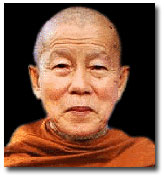 News that will sadden many people in Cambodia and across the globe is the death of Maha Ghosananda, a Nobel Peace Prize-nominated monk who was a major factor in the rebirth of Buddhism in Cambodia after the fall of the Khmer Rouge. He passed away in the US, where he'd been a frequent visitor since the late '80s. Born in 1929 in Takeo, he was elected a Supreme Cambodian Buddhist Patriarch by fellow monks in 1988 for his tireless efforts to revive Buddhism, human rights and for peace. In advocating the latter, he led a series of 'Dhammayietra' peace walks in Cambodia in the '90s and received four Nobel Peace Prize nominations for his efforts. Tributes have been flowing in already for the 'Father of Cambodian Buddhism' and his wisdom, patience and understanding will be sorely missed in his mother country, where he was held in such high esteem.
News that will sadden many people in Cambodia and across the globe is the death of Maha Ghosananda, a Nobel Peace Prize-nominated monk who was a major factor in the rebirth of Buddhism in Cambodia after the fall of the Khmer Rouge. He passed away in the US, where he'd been a frequent visitor since the late '80s. Born in 1929 in Takeo, he was elected a Supreme Cambodian Buddhist Patriarch by fellow monks in 1988 for his tireless efforts to revive Buddhism, human rights and for peace. In advocating the latter, he led a series of 'Dhammayietra' peace walks in Cambodia in the '90s and received four Nobel Peace Prize nominations for his efforts. Tributes have been flowing in already for the 'Father of Cambodian Buddhism' and his wisdom, patience and understanding will be sorely missed in his mother country, where he was held in such high esteem.
Tuesday, March 13, 2007
New Year Baby film poster
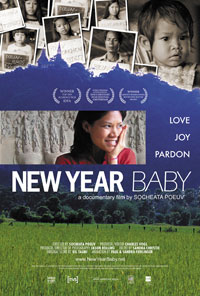 The eagerly-awaited documentary New Year Baby will be screened in the UK at the weekend and an interview with Director/Producer Socheata Poeuv will appear in this blog sometime soon. Stay tuned. For an in-depth look at the making of the film, go to www.newyearbaby.net.
The eagerly-awaited documentary New Year Baby will be screened in the UK at the weekend and an interview with Director/Producer Socheata Poeuv will appear in this blog sometime soon. Stay tuned. For an in-depth look at the making of the film, go to www.newyearbaby.net.
Monday, March 12, 2007
New Year Baby screening in UK
 Okay folks, its finally here, the most talked about documentary on Cambodia for a long time. New Year Baby is a personal 75 minute expose by Socheata Poeuv, whose family ultimately survived the genocide under Pol Pot’s Khmer Rouge and settled in the US. Years later her parents reveal a secret that they have kept hidden from her for 25 years - a secret that leads to further revelations when she returns with her parents and brother for the first time to Cambodia. Socheata was born on the Cambodian New Year in a Thai refugee camp. The documentary has earned prizes, awards, accolades and kudos from just about every corner of the globe as it does the round of all the prestigious film and documentary festivals, and its finally made it to England. You have three opportunities to see it in England as part of the OXDOX : MK Film Festival, which is showing over 100 international documentaries between 10th-25th March in Oxford, London and Milton Keynes.
Okay folks, its finally here, the most talked about documentary on Cambodia for a long time. New Year Baby is a personal 75 minute expose by Socheata Poeuv, whose family ultimately survived the genocide under Pol Pot’s Khmer Rouge and settled in the US. Years later her parents reveal a secret that they have kept hidden from her for 25 years - a secret that leads to further revelations when she returns with her parents and brother for the first time to Cambodia. Socheata was born on the Cambodian New Year in a Thai refugee camp. The documentary has earned prizes, awards, accolades and kudos from just about every corner of the globe as it does the round of all the prestigious film and documentary festivals, and its finally made it to England. You have three opportunities to see it in England as part of the OXDOX : MK Film Festival, which is showing over 100 international documentaries between 10th-25th March in Oxford, London and Milton Keynes.
Sunday, March 11, 2007
Loung Ung penned article 2
 The second article written by Loung Ung which I located at the International Museum of Women website was one called Missing Cambodia, which Loung penned for World Pulse magazine in 2006:
The second article written by Loung Ung which I located at the International Museum of Women website was one called Missing Cambodia, which Loung penned for World Pulse magazine in 2006:
I spent the first ten years of my life in Cambodia. I have precious memories of my childhood there before my family was forced out of the city in a mass evacuation into the countryside. Cambodia will always possess my heart and soul. Before the war, my early years were filled with innocence, magic, and family. And now, somewhere in the Cambodian soil lie my parents’ bones. I imagine their souls flying freely there. Recently I bought a little piece of land in Cambodia. I dream of going back one day, building a shack on my piece of land and living there. I was twenty-five when I went back for the first time on my way home from attending the Beijing Women’s Conference. I had to revisit Cambodia to start the healing process and to overcome the fear of war that I carried in my heart, mind, and soul. If you leave a war-torn country, you take the images of war with you. But when I went back, I saw that things were different. Returning to Cambodia not only allowed me to reunite with my siblings but also with my culture. Though they are no longer with me, I also felt like I was reconnecting with my parents through their spirits that were so tied to the land. It was a deeply spiritual journey. Now after twenty trips or so back, I have replaced many images of war with wonderful new memories.
Going back changed my life. When I returned from my first trip, I knew that I wanted to spend my life working on issues related to Cambodia and the landmine crisis. Within months, I had left my job as an advocate at a domestic violence shelter, packed my bags, and moved to Washington DC. I found the Vietnam Veterans of America Foundation, and was hired as a spokesperson for the Campaign for a Landmine Free World (CLFW). My mission now is to give people who have survived wars a chance to survive peacetime. Since 1980, I have benefited from living in America. First of all, I haven’t had to fight soldiers, go hungry, die from curable illnesses, or get blown to bits by landmines. In America, there was no question that I would survive the peace time. America has given me a home and I love it here. I love my friends, the generous people with whom I work, the culture, and the freedom. There are so many things that are 'right' here. But I also love Cambodia. In Cambodia, it takes a village to raise a child. Many people in my sister’s village of 2,000 know each other. The villagers look out for each other's children. Anybody’s parents can tell kids “don’t pick up that stone and put it in your mouth.” The wooden doors are kept wide open. There are no glass windows enclosing airless rooms.
When I go back, I visit my sister’s village. There are difficulties in the village, poverty, and not enough business for sustenance. People are poor but are eking out a living. City life can also be difficult with AIDS, the sex trade, and corruption. I wish I could get involved with the other fights as well but I cannot. I try to assist, connect people, and do what I can for those other battles, but I have chosen mine: the battle with landmines. What I miss the most about Cambodia is my family. And the food! I miss getting up in the morning to a steaming bowl of noodle soup. I miss eating fruits that are picked ripe from the tree. I miss the rainwater and people who find joy in its free fall. I miss people who dance and sing with joy just because it’s raining and because they don’t have to walk miles to find water. I miss the non-verbal language, the communicating without words. I miss women being really close and holding hands, and men caring for each other and giving each other hugs. I miss being able to pick up kids and being able to kiss them with affection. I miss the sight of five little shacks that sell the exact same thing - all nuts and bolts. Who you buy from is all about relationship and who you know. The competitors are often friends and do not talk badly about each other. I miss the music. I miss the hauntingly beautiful flute notes that stir the heart and move even the stones in the temple ruins of Angkor Wat. I miss the songs sung by the lips of children who never tasted war. I miss the bells - little hand bells, finger bells, cowbells, and anklets - the sound of those bells, that’s music to me.
I dream that someday Cambodia can become healthier and happier both spiritually and economically. I hope that the Cambodians will get the financial help they need on their road to progress. I hope that the wounds caused by the ghosts of past wars will heal. For human beings, healing is a natural process, and the Cambodians are slowly becoming conscious of their healing. I believe the first generation of babies born healthy after the war is helping us in this healing process. I believe Cambodia is learning to live in color again. In the times of Khmer Rouge, we were given black pants and black shirts to wear. It was as if the country was in mourning for four years. Black was the uniform in our prison without walls, black was the terror that pierced our hearts when the soldiers came for our fathers, black was the earth soaked with the blood of the innocents, and black were the silent sentinels of death in the form of the landmines littered in our beautiful land. But we, the survivors, are learning to wear colorful clothes and wear them fearlessly, proudly, and with strength. Our colors will overcome the black. All of us have such incredible power to bring color into this world. But we cannot do it alone. I am but one person, but together, in numbers, we can work towards building powerful campaigns to make a difference in the world today.
(As told to Ramya Ramanathan, Global Editor, World Pulse Magazine).
Loung Ung penned article 1
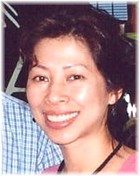 With a raft of interviews with Loung Ung just about to hit the news-stands and radio airwaves following her all-too-brief visit to the UK this week, I came across two articles by Loung herself, which you might like to read. I found them at the International Museum of Women website and this first article was from their December 2006 focus on War & Dialogue: Peacemakers. It was titled, Surviving the killing fields of Cambodia.
With a raft of interviews with Loung Ung just about to hit the news-stands and radio airwaves following her all-too-brief visit to the UK this week, I came across two articles by Loung herself, which you might like to read. I found them at the International Museum of Women website and this first article was from their December 2006 focus on War & Dialogue: Peacemakers. It was titled, Surviving the killing fields of Cambodia.
Saturday, March 10, 2007
Loung Ung in the UK
 The good news is that Loung Ung is already in the UK, the not so good news is that she's not scheduled to make any public appearances whilst she's here. Instead, Mainstream, who are publishing her two books in paperback this month, have asked her to complete a round-robin of press interviews that will include an article by Jon Swain in a future Sunday Times edition, she's just this minute finished an interview with BBC World Radio, not to mention interviews with press from Scotland, Ireland, Sweden and all points in between. However, don't dismay, you should be able to catch her at the Edinburgh International Book Festival in August.
The good news is that Loung Ung is already in the UK, the not so good news is that she's not scheduled to make any public appearances whilst she's here. Instead, Mainstream, who are publishing her two books in paperback this month, have asked her to complete a round-robin of press interviews that will include an article by Jon Swain in a future Sunday Times edition, she's just this minute finished an interview with BBC World Radio, not to mention interviews with press from Scotland, Ireland, Sweden and all points in between. However, don't dismay, you should be able to catch her at the Edinburgh International Book Festival in August.
Note: The full Loung Ung interview by Jon Swain, with photos, is scheduled to appear in The Sunday Times News Review on Sunday, 18th March. Don't miss it.
Friday, March 09, 2007
A surprise for Sophal
Sak and his family from Battambang
Thursday, March 08, 2007
Cambodia's loss, Australia's gain...
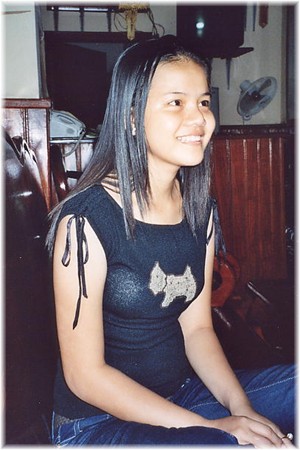 Temporarily, Australia has been gifted one of Cambodia's unsung gems, in the arrival of Kim, the eldest child of the family who own and run my favourite guesthouse in Siem Reap, the Shadow of Angkor. She left her family for the first time, and what an emotional departure that was, at the end of January to begin 4 years of study at a university near Sydney in Australia. And what a great party her parents put on to mark her departure too. In her heart I know she'd like to be a journalist, but commerce is her chosen main subject and she's well aware of how fortunate she is to be able to study abroad and to have the full backing of her family behind her. Kim, with her gorgeous personality and mischievous sense of humour, was the life and soul of the guesthouse and I know she'll be greatly missed by her family, friends and regular guests. She is so determined to grab this opportunity with both hands, and I'm convinced she'll be a success at whatever she aims for. More on the Shadow of Angkor GH here.
Temporarily, Australia has been gifted one of Cambodia's unsung gems, in the arrival of Kim, the eldest child of the family who own and run my favourite guesthouse in Siem Reap, the Shadow of Angkor. She left her family for the first time, and what an emotional departure that was, at the end of January to begin 4 years of study at a university near Sydney in Australia. And what a great party her parents put on to mark her departure too. In her heart I know she'd like to be a journalist, but commerce is her chosen main subject and she's well aware of how fortunate she is to be able to study abroad and to have the full backing of her family behind her. Kim, with her gorgeous personality and mischievous sense of humour, was the life and soul of the guesthouse and I know she'll be greatly missed by her family, friends and regular guests. She is so determined to grab this opportunity with both hands, and I'm convinced she'll be a success at whatever she aims for. More on the Shadow of Angkor GH here.
Wednesday, March 07, 2007
Toun Sokheng - revisited
 On 12 June 2006 I posted a blog entry entitled Toun Sokheng - a priceless gem, about a woman I met in a small village in the wilds of northern Cambodia in January 2006. I thought she was such good company that my pal Sokhom and I returned to her village, Kalapia, a month ago, during my most recent Cambodia trip. And there she was, as friendly, generous, honest, amusing and as gracious a host as before. Some things in Cambodia never change, one of them being the generosity of spirit of her people.
On 12 June 2006 I posted a blog entry entitled Toun Sokheng - a priceless gem, about a woman I met in a small village in the wilds of northern Cambodia in January 2006. I thought she was such good company that my pal Sokhom and I returned to her village, Kalapia, a month ago, during my most recent Cambodia trip. And there she was, as friendly, generous, honest, amusing and as gracious a host as before. Some things in Cambodia never change, one of them being the generosity of spirit of her people.
Tuesday, March 06, 2007
Cambodian women under the spotlight
Is it just me, or do women, generally speaking, get a bum deal in Cambodia? I don't want to start a debate but in my limited experience, they are the fabric that keeps everything together, they work extraordinarily hard, yet they are still seen as second-class citizens in many ways. So its good to see that the Nordic Institute of Asian Studies are bringing out two books which will give a greater focus on women in Cambodia and the uphill battle they face. Trudy Jacobsen's Lost Goddesses: The Denial of Female Power in Cambodian History highlights the lofty position women once held against their struggle to regain that lost ground today. Its published next month, while Mona Lilja's new book, due out in June, will give a unique insight into the political struggles of Cambodian women. Its called Power, Resistance and Women Politicians in Cambodia: Discourses of Emancipation. You can find out more at NIASPress.
New Cambodia documentaries
In my desire to highlight and promote all films, documentaries, books and so forth that focus on Cambodia, I have news of new documentaries in progress. Cambodian Dreams, produced by Stanley Harper, has been 18 years in the making as he followed the fortunes of Yan Chhieng and her family, beginning in the Site 2 refugee camp in Thailand. Its due to be shown on Cambodian tv later this year and may even get a viewing at film festivals this Spring. Meanwhile, acclaimed documentary filmmaker Bob Elfstrom is still shooting a yet-untitled documentary on a rising star in the world of dance, Sar 'Sy' Sokvannara, a gifted Cambodian dancer who's trained at the School of American Ballet and is currently an apprentice with the Pacific Northwest Ballet School in the Seattle. The documentary will chronicle Sokvannara’s journey as a dancer as he uses the skills he learned from traditional, ritualistic Cambodian dances on the ballet stage in America.
In addition, you might be interested in these already-completed documentaries. Produced in September 2006, A Few Drops in Cambodia: Stories From a Relief Effort, is a documentary that highlights the challenges NGOs/donors face in seeking to provide health care to those most in need in Cambodia. Watch it here. Eliminated Without Bleeding is a touching and revealing one-hour documentary on the Khmer Krom indigenous peoples from the Mekong Delta in Southern Vietnam and which highlights evidence of human rights abuse. It's written, directed and produced by Rebecca Sommer. Watch it here. And if you haven't seen it on your cable channel yet, Les Guthman's superbly photographed 70-minute Churning the Sea of Time: A Journey Up The Mekong to Angkor, released last year, is now available from Amazon.com and elswehere.
Monday, March 05, 2007
The Drum - 2 events not to be missed!
 The Drum, just ten minutes outside Birmingham city centre, is the UK's premier arts venue dedicated to African, Asian and Caribbean arts and cultural activities. There are two forthcoming events that I really want to see, involving two musical friends of mine. On Tuesday 17 April at 7pm, Who Shot the Sheriff, is the story of the Rock Against Racism movement featuring unseen footage of artists of the 70's and the Love Music Hate Racism (LMHR) movement today. Groups like Steel Pulse, Sham 69, The Clash and Ms Dynamite will be featured. The film tracks the rise of racism and the National Front in Britain and how a generation, black and white, fought back. There will be a post screening discussion and songs from Birmingham's very own singer songwriter Yaz Alexander. Incidentally Yaz will also be supporting the Mighty Diamonds at the same venue, on 17 March.
The Drum, just ten minutes outside Birmingham city centre, is the UK's premier arts venue dedicated to African, Asian and Caribbean arts and cultural activities. There are two forthcoming events that I really want to see, involving two musical friends of mine. On Tuesday 17 April at 7pm, Who Shot the Sheriff, is the story of the Rock Against Racism movement featuring unseen footage of artists of the 70's and the Love Music Hate Racism (LMHR) movement today. Groups like Steel Pulse, Sham 69, The Clash and Ms Dynamite will be featured. The film tracks the rise of racism and the National Front in Britain and how a generation, black and white, fought back. There will be a post screening discussion and songs from Birmingham's very own singer songwriter Yaz Alexander. Incidentally Yaz will also be supporting the Mighty Diamonds at the same venue, on 17 March.
Sunday, March 04, 2007
Update on Vansy
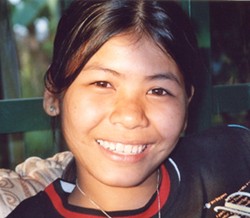 My recent return to Cambodia allowed me to meet up with lots of old friends and one in particular, Vansy. She's now 14 and growing up so fast, is doing really well at regular school and is so determined to learn and speak English to give herself, as she tells me, the chance of a career as a teacher or tour guide. I wanted to see the standard of the extra English classes she receives for an hour each day so I paid an unannounced visit to her evening class, only to find that the teacher was absent, so I took an impromptu lesson myself. It was abundantly clear that she's a 'leader' amongst her peers, the other students look up to her and her English is improving leaps and bounds each time I see her. We practised as much as we could in the few days I was with her and her family and I'm so proud of the way she applies herself and absorbs everything. I've now been afforded the privilege of 'god-father' status, which I will take very seriously. She's as bright as a button and I hope I can help her blossom into a confident and successful young woman. You can read more about Vansy here.
My recent return to Cambodia allowed me to meet up with lots of old friends and one in particular, Vansy. She's now 14 and growing up so fast, is doing really well at regular school and is so determined to learn and speak English to give herself, as she tells me, the chance of a career as a teacher or tour guide. I wanted to see the standard of the extra English classes she receives for an hour each day so I paid an unannounced visit to her evening class, only to find that the teacher was absent, so I took an impromptu lesson myself. It was abundantly clear that she's a 'leader' amongst her peers, the other students look up to her and her English is improving leaps and bounds each time I see her. We practised as much as we could in the few days I was with her and her family and I'm so proud of the way she applies herself and absorbs everything. I've now been afforded the privilege of 'god-father' status, which I will take very seriously. She's as bright as a button and I hope I can help her blossom into a confident and successful young woman. You can read more about Vansy here.
Saturday, March 03, 2007
Peace & Reconciliation...in Oregon
The Khmer Rouge Tribunal, currently stumbling along inside Cambodia, will reach far and wide at the end of next month. On April 27 & 28, the Cambodian-American Community of Oregon (CACO) will hold a free public forum to raise awareness about the Tribunal. The two-day forum will take place in Portland and the event will include panel discussions by Khmer Rouge genocide survivors and scholars of Cambodian history and culture, as well as presentations and performances by authors, musicians, and community activists. Any Cambodia watcher will know that the United Nations and the Cambodian government are scheduled to prosecute surviving senior Khmer Rouge leaders sometime in 2007, but no-one knows what effect this may have on the Cambodian population, though it is hoped that it will bring a sense of closure and healing for many of the survivors of the Khmer Rouge regime. An estimated 250,000 refugees from Cambodia currently reside in the US, with approximately 10,000 living in Oregon and SW Washington. CACO believes it can help community members cope with individual and collective trauma by confronting the past and exploring the effects of the Khmer Rouge genocide, including post-traumatic stress disorder and will use the forum to inform and educate the general public about the long-term effects of genocide.
The line-up of speakers is an impressive one. It includes Sichan Siv, former US Ambassador to the UN; Loung Ung, renowned author featured often in this blog; Daran Kravanh, internationally renowned musician; Beth Van Schaack, legal advisor to Documentation Centre of Cambodia; Alex Hinton, author of Why Did They Kill? Cambodia in the Shadow of Genocide; and Craig Etcheson, author and prosecutor for the Tribunal, alongwith Ronnie Yimsut, author and organiser of the event. Visit www.CACOregon.org.
Friday, March 02, 2007
Loung Ung
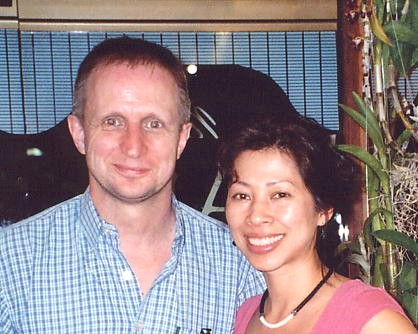 I posted a blog-item on Loung Ung a few days ago and forgot to include this photo of Loung and myself, taken when we joined up for a chat and a meal in Phnom Penh during my recent visit to Cambodia. Loung was in Cambodia seeing family and writing an outline for her new book (sorry, I'm sworn to secrecy). She is scheduled to come to London in the next month or so for the publication of both her books in England & Europe, so I hope we can catch up again, this time on my home territory. This lady holds a special place in a lot of hearts around the globe, and mine is no exception.
I posted a blog-item on Loung Ung a few days ago and forgot to include this photo of Loung and myself, taken when we joined up for a chat and a meal in Phnom Penh during my recent visit to Cambodia. Loung was in Cambodia seeing family and writing an outline for her new book (sorry, I'm sworn to secrecy). She is scheduled to come to London in the next month or so for the publication of both her books in England & Europe, so I hope we can catch up again, this time on my home territory. This lady holds a special place in a lot of hearts around the globe, and mine is no exception.
You can read more about Loung Ung here.
